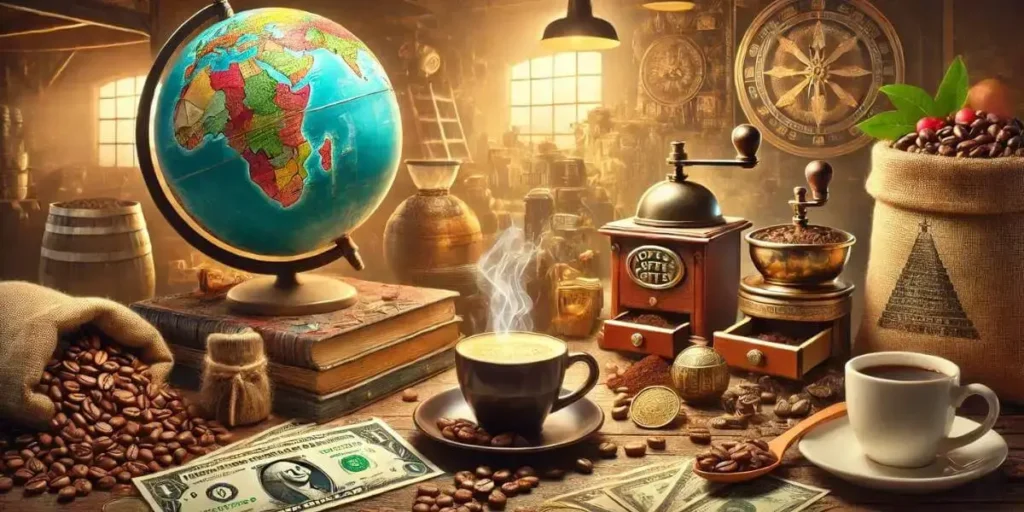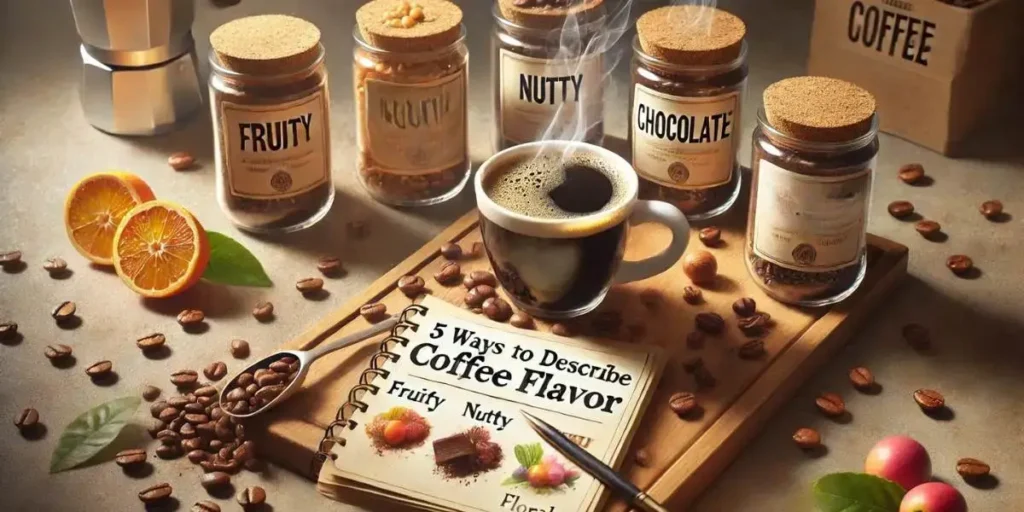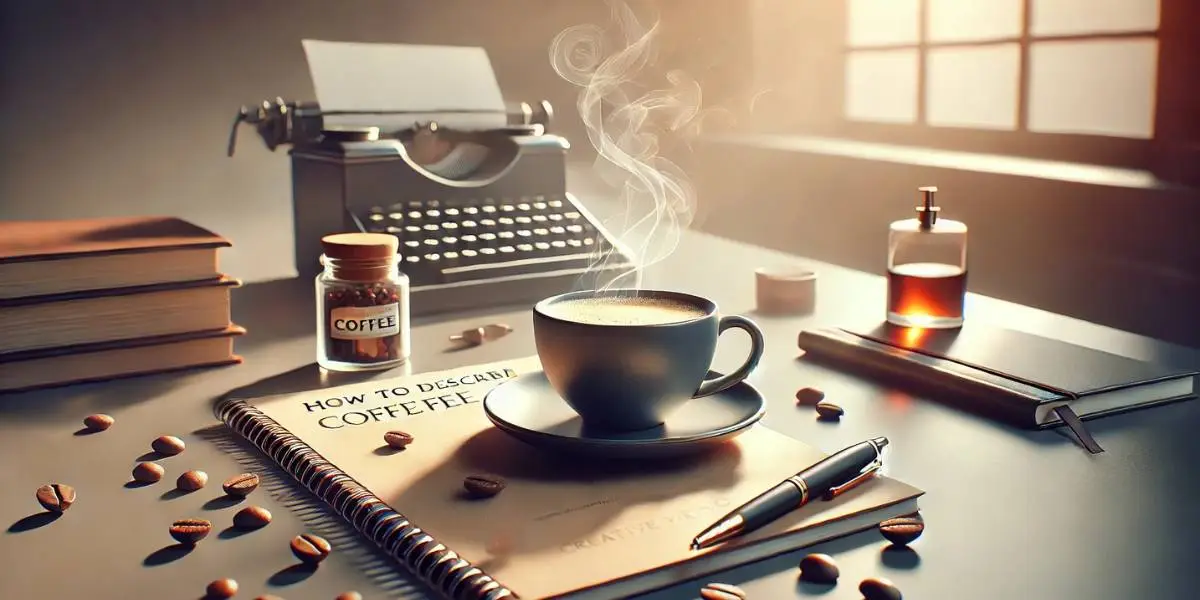Describing coffee in creative writing is an essential skill for any writer looking to craft vivid, engaging scenes that captivate readers. From the aroma of a freshly brewed cup to its rich, complex flavor, coffee is more than a drink—it’s an experience.
As you write, focus on the sensory language that can transport your audience to a cozy coffee shop or a bustling café. Highlight the notes of chocolate, caramel, nuts, and even fruit, allowing the scene to take on depth and texture. Writing with vivid imagery makes your readers visualize and even feel the energy of the story.
The smooth, creamy texture of coffee contrasts beautifully with its bold, robust flavor, making it an excellent tool for setting the tone of a moment. A well-brewed cup can evoke emotions, from the comforting ambiance of a quiet morning to the liveliness of an afternoon café scene.
By focusing on hints of sweetness, bitterness, and the lingering aftertaste, you create an immersive sensory journey. The magic lies in the fusion of five characteristics—taste, smell, texture, sight, and emotion—all blending seamlessly into an authentic, layered profile that reflects the unique nature of coffee beans.
How to Describe Coffee in Creative Writing
To creatively describe coffee in writing, focus on engaging all five senses: its aroma (earthy, nutty, floral), taste (rich, bright, bittersweet), mouthfeel (velvety, smooth), sight (dark, steaming), and sound (gurgle, pour). Use strong, descriptive words and make comparisons to help your reader really see what you’re describing.
Don’t forget the mouthfeel, whether it’s smooth, velvety, or lingering, which adds texture to the narrative. Even the sound of the pour can be described with language that paints a vivid picture for the reader. By including comparisons and considering the specific roast level, origin, and brewing method, your descriptions gain depth and authenticity, making them as satisfying as the perfect cup.
Creative Coffee Description Tips!
- Engage all five senses when describing coffee: sight, smell, taste, touch, sound.
- Use vivid adjectives like “velvety,” “earthy,” “robust,” “fragrant.”
- Compare coffee to other experiences or emotions to evoke feeling.
- Consider the atmosphere or setting where the coffee is consumed.
The History and Origins of Coffee

To truly capture the essence of coffee in creative writing, delve into its rich history, which dates back to the 15th century. Imagine the legend of a curious goat herder in Ethiopia who noticed his goats acting unusually energetic after eating berries from a mysterious tree. Intrigued, he tried them himself and discovered an unparalleled surge of energy, unknowingly beginning a transformative journey for humanity.
From its humble beginnings, the consumption of coffee spread like wildfire across the Middle East, enchanting palates before crossing into Europe and the Americas. With each sip, the world embraced this discovered treasure, marveling at its ability to spread energy and inspiration, much like the herder’s tale that started it all.
Types of Coffee and Their Characteristics
When writing creatively about coffee, highlighting its diverse types and brewing methods can make your descriptions vivid and relatable.
Picture the rich flavor of espresso
A strong, concentrated drink made by forcing hot water through finely ground beans.
Imagine the creamy indulgence of a latte
Crafted with steamed milk, it offers a smooth and velvety experience.
Delight in the balance of a cappuccino
Topped with fluffy foam, it perfectly balances espresso and steamed milk.
Consider the simplicity of an American
A straightforward combination of hot water and espresso.
Explore the boldness of the French press
This method involves steeping coarse grounds in water and filtering through a mesh filter for a robust flavor.
Each brewing style offers unique sensory elements that can Each brewing style offers unique sensory elements that can enrich your storytelling, turning coffee into a character of its own.your storytelling, turning coffee into a Each brewing style offers unique sensory elements that can enrich your storytelling, turning coffee into a character of its own. of its own.
Coffee’s Role in Culture and Economy

Coffee is an important crop, especially in developing countries, where it provides employment and income to millions of people. However, the industry faces challenges, such as low prices for farmers and environmental concerns.
By supporting fair trade options and sustainable farming practices, consumers can help secure a better future for producers and the environment, ensuring the significance of coffee remains intact.
Beyond its cultural appeal, coffee consumption impacts the global economy, generating billions of dollars annually. It’s a complex and fascinating subject with a rich history and diverse types that carry profound economic implications.
Yet, the reality for farmers is stark: ninety percent of the world’s coffee is grown using cheap labor in developing countries, while profits flow to developed, industrialized nations.
The irony lies in how this luxury, addictive crop, offering no nutritional value, is exported while locals endure malnutrition. Price drops by even one or two percent can devastate families in places like Sierra Leone, where they rely on cash crops to survive.
Increasing deforestation and resource centralization worsen these issues, showing the true cost of slavery in modern times. Supporting fair trade and ensuring proper food in ample supply are the only ways forward.
The Taste and Aroma of Coffee
The taste and aroma of coffee are among its most important aspects, creating a unique flavor profile that’s often described using rich adjectives. For instance, coffee can be sour, with a sharp, acidic bite, or sweet, evoking a sugary, caramel-like smoothness.
Some cups are bitter, offering a strong, pungent sensation, while others have fruity notes reminiscent of berries, citrus, or other fruit. Coffee may also feel nutty, like almonds or hazelnuts, or carry caramelly, chocolaty tones with hints of lemon, orange, or grapefruit.
Tasting and enjoying coffee is a multi-sensory experience, where the smell alone triggers a feeling of alertness and energy. Walking into a favorite coffee shop or the kitchen as it’s brewing sends signals to the brain, heightening anticipation.
Coffee acidity and other sensations make this process both familiar and invigorating. With over 800 aromatics identified, its complexity continues to amaze. Roasting coffee beans changes the aroma, with darker roasts carrying a powerful aroma but losing some scent compared to lighter roasts.
Freshly brewed coffee has a more potent fragrance than older coffee, with the aroma most evident in a large pot. As you drink to the bottom, the general aroma fades, leaving a fleeting but enjoyable memory. Descriptors like fragrant, floral, or resinous (like pine) bring coffee’s spicy notes—cinnamon or cloves—to life.
Even an enzymatic breakdown in coffee compounds can enhance its natural intensity. Whether it tastes dry and cardboard-like, like cereal with no milk, or like hot chocolate balanced with milk and sugar, coffee always leaves a palatable impression.
Key Coffee Aroma Descriptors
- Smoky
- Fruity
- Herbal
- Floral
- Nutty
- Complex
Texture, Body, and Mouthfeel
The texture and body of coffee define its physical properties and how it feels in your mouth, adding depth to its sensory appeal. A creamy, smooth, or velvety texture suggests richness, while a thin, watery, or insubstantial texture feels light and delicate.
Some coffees are full-bodied, offering a substantial presence, while others are light-bodied, characterized by a subtle and refined mouthfeel. Using descriptive words and adjectives to describe coffee’s physical sensations helps connect its life and flavor to the reader, making it more vivid in creative writing.
The term coffee body also refers to its weight, viscosity, and how it rests on your tongue, playing an influential role in its flavor. Much like the texture of food, such as sushi or coconut, the unique feel of coffee shapes our perception of it.
Before brewing, coffee feels like sand, not as soft, but more like clean cat litter or small pebbles. Once brewed, it transforms into a liquid that can be hot, leaving a sticky residue after cooling. These ever-changing, intriguing layers make coffee an engaging sensory experience worth exploring.
Terms for Describing Coffee Body
A Cold Brew Reserve typically carries a buttery texture with a heavy body, offering a smooth, indulgent mouthfeel that coats the palate.
In contrast, a thin or watery coffee lacks depth and richness, making it feel light and almost insubstantial, unlike the satisfying syrupy consistency found in denser brews.
Aftertaste and Lingering Notes
The aftertaste of coffee is the taste that lingers in your mouth after it has been swallowed, leaving a lasting impression. It can be described with adjectives and descriptive words like bitter, offering a strong, pungent sensation, or sweet, providing a lingering, sugary delight.
Some coffees have a salty note, reminiscent of salt, while others feel nutty, bringing hints of nuts, almonds, or hazelnuts. For a refreshing twist, the fruity flavors of berries, citrus, or other fruit create a vibrant and memorable finish.
The aftertaste is a combination of aroma and taste, influenced by every sip. It’s a byproduct of all the flavor elements, from the coffee acidity on the tip of your tongue to the scent that fills the kitchen. Each step plays a role in shaping the flavor experience from beginning to end.
A high-quality coffee bean, carefully grown, harvested, and roasted by experts, produces a magical aftertaste that pleasantly lingers. To fully enjoy it, try slowly breathing in and out after swallowing, allowing your mind and body to focus entirely on the sensations and deepen your connection to the coffee.
Understanding Roast Profiles
The roast profile of coffee refers to the degree to which the coffee beans have been roasted, influencing their color, flavor, and acidity.
Light Roast
A light roast offers a light brown hue, with a mild flavor and noticeable acidity.
Medium Roast
A medium roast showcases a medium brown color and a balanced flavor with moderate acidity.
Dark Roast
A dark roast is characterized by its dark brown shade, strong, bold flavor, and low acidity, creating a unique sensory experience.
By focusing on the roast profile and incorporating descriptive words and adjectives, writers can enhance their storytelling. Describing the taste, aroma, texture, aftertaste, and roasting styles of coffee adds a vivid, engaging experience for the reader. It enables them to connect with the scene and savor the sensory richness of the coffee through the words.
- Does NOS Energy Drink Have Caffeine? Expert Guide (2025)
- Does Bubbl’r Sparkling Water Have Caffeine? Full Breakdown In 2025
- Does Elderberry Energy Drink Contain Caffeine? Complete 2025 Review
Exploring Coffee Through Sight and Sound
Coffee has its own unique sounds throughout its journey. Before brewing, coffee grounds are tiny, solid chunks resembling dirt, and pouring them into a cup creates a sound similar to rice being poured into a pot on a stove. During brewing, a coffee machine produces a noise like water boiling mixed with the sound of water going down a drain in a bathtub.
The bubbling effect is akin to a bubble bath draining. Once brewed, coffee sounds like any other liquid, with drinkers producing gulping or swallowing noises. If spilled on a table or floor, it makes a splashing sound similar to milk or water.
Visually, coffee changes as it brews. Before brewing, it looks like little chunks of dirt, with a dark brown, nearly black color. After passing through the coffee machine, it becomes brighter, yet still brown, resembling muddy water or chocolate milk if too much chocolate syrup is added. These transformations in sound and appearance create a dynamic sensory experience that enhances its appeal.
The Coffee Experience
Coffee is a complex drink with a wide range of flavors, aromas, textures, and aftertastes. In creative writing, describing coffee can bring a vivid, sensory experience to the reader, making the scene more immersive. With thoughtful tips and a creative, engaging approach, writers can use coffee as a tool to captivate the audience and add depth to their storytelling.
Crafting the Perfect Cup
Describing the perfect cup of coffee can be challenging as it varies for each person, but there are some common characteristics most enjoy. A good cup of coffee is often warm, strong, and smooth, with a rich flavor that is neither too bitter nor too acidic.
While some people prefer their coffee black, others like to add milk and sugar. Caramel, chocolate, and hazelnut are also popular flavorings that can enhance the taste and elevate the overall experience.
The Ambiance of a Coffee Shop
The ambiance of a shop can greatly affect the coffee experience. A cozy and welcoming environment creates a better connection with the taste of freshly brewed coffee and its intoxicating scent drawing customers through the door.
With comfortable seating, good coffee shops often encourage people to stay and enjoy a moment of calm. A well-designed interior with plants, natural lighting, and a relaxing atmosphere adds to the pleasant and calming charm, making it a perfect escape.
The Ritual of Morning Coffee
For many, coffee is an essential part of their morning ritual, offering a comforting routine that bridges the gap between sleeping and being awake. The first sip is often a moment of pure bliss, providing the energy to start the day.
Paired with breakfast, the combination of coffee and food creates a delightful experience. Whether it’s a quick cup on the go or a leisurely morning at a coffee shop, the act of enjoying a perfect cup becomes a memorable source of comfort and enjoyment, highlighting the ambiance and connection that coffee brings to daily life.
Coffee Language and Vocabulary
When describing coffee, a variety of terms and phrases can help convey its unique qualities and characteristics. From casual slang and creative nicknames to precise descriptors and tools like the coffee flavor wheel, the rich language of coffee offers endless ways to connect with this beloved beverage.
Understanding these nuances allows you to truly appreciate and enjoy the depth and complexity of coffee, making it even more meaningful to write about and savor.
Coffee Slang, Nicknames, and Jargon
Coffee has a rich history and culture, leading to a variety of slang terms and nicknames that reflect its universal appeal. For example, Jo is a shortened version of “java,” a popular term for coffee. Mud refers to the thick, rich consistency found in certain types of coffee.
The name Starbucks, a popular coffee chain, has become almost synonymous with coffee itself. Another casual term, cop, stands for a “cup of coffee.” These creative terms highlight the unique ways people connect with their favorite drink across different cultures.
Descriptive Terms for Coffee Flavors
When describing the taste and aroma of coffee, there are a variety of specific descriptors and terms that capture its unique character. A coffee described as bright often has a high level of acidity and a sharp, tangy flavor.
A flowery coffee carries a delicate, floral aroma, while a nutty flavor suggests a rich, nutty flavor with hints of almond or hazelnut. By using these descriptors, coffee lovers can communicate effectively and highlight the unique qualities of their favorite brews, making each cup more meaningful to share and savor.
The Coffee Flavor Wheel Explained
The coffee flavor wheel is a valuable tool for describing the taste and aroma of coffee. It breaks down the various flavors and aromas found in coffee, such as fruity, floral, nutty, and chocolatey notes. By using the wheel, coffee drinkers can more accurately describe the specific qualities of their favorite brews and better understand the nuances of different types of coffee.
The language of coffee is rich and complex, offering a variety of terms and phrases to describe its unique qualities. For coffee lovers, understanding these details allows them to appreciate and enjoy the different flavors and aromas of this beloved beverage.
5 Ways to Describe Coffee Flavor

Though coffee may seem like a one-ingredient drink, its complexities are endless. Even without creamers or sweeteners, the flavor is complex and intricate, shaped by the type and quality of the coffee beans and the water used.
Growing and roasting processes play an integral role, in altering the final product. Adding sugar, milk, or creamer changes the flavor after the beans are harvested, turned into coffee grounds, and brewed into your morning cup.
The categories used for dissecting and describing the flavor profile—whether in a story about a cop or a personal moment—help capture its tastes, which can range from bold and rich to smooth and balanced.
Coffee Acidity
Coffee acidity often gets a bad rap because of its negative connotation, but in actuality, it’s a positive sensation many coffee drinkers enjoy without realizing it. The definition of coffee acidity is a pleasing sharpness felt at the front of your mouth, sometimes as a numbing sensation on the tip of your tongue, dryness along the edges, or on the backside of the palate.
Unlike its name, coffee acidity isn’t about the pH level, which averages between 4.8 and 5 and remains consistent regardless of how acidic the coffee flavor feels. Descriptive terms like crisp, tart, dry, sharp, vibrant, lively, sweet, or dull help captures its complexity, making coffees like Stone Street Coffee Dark Roast stand out.
Coffee Aroma and Fragrance
Tasting and enjoying the flavor of coffee is a multi-sensory experience where the smell alone can bring a sense of alertness and energy. The aroma from a favorite coffee shop or your kitchen while the coffee is brewing signals your brain about the richness that awaits. With over 800 aromatics, and new aromatics being discovered regularly through advances in testing techniques, the layers of coffee aroma are complex.
Roasting coffee beans shapes this fragrance; darker roasts, while offering a powerful aroma, carry less scent than lighter roasts. Fresh coffee delivers a potent fragrance, unlike older coffee, where the general aroma diminishes as you brew and drink down to the bottom of the large pot, making its once-vivid scent less detectable.
Bitterness and Sweetness in Coffee
Bitterness in coffee often carries a negative connotation, but when experienced in moderation, it can create a pleasing balance with the sweetness of the drink. Coffee beans are linked to 21 sources of bitterness, including caffeine, acids, proteins, and alcohols.
Chlorogenic acids are the primary source of bitterness in light and medium roasts, while dark roasted beans produce phenyl compounds when heated above 425 degrees, intensifying the bitter flavor.
A knowledgeable coffee roaster can craft a wonderful dark roast, avoiding the overly bitter elements caused by over-roasting or over-extraction. When bitterness dominates, it can overpower sweet-sugar flavors and fragrance, often leading to confusion with coffee acidity, as seen in a well-crafted cup like Abie’s Irish Creme Coffee.
Coffee Body and Texture
The body of coffee refers to its mouthfeel, encompassing its weight, texture, and viscosity on the tongue. This plays an influential role in shaping the coffee flavor, much like how food texture affects our perception of sushi or coconut. Some people love these sensations, while others cannot get past them.
When describing coffee, terms like thin, watery, syrupy, heavy, or buttery help paint a vivid picture. A glass of Cold Brew Reserve, for instance, may lean towards a syrupy or buttery texture, making its mouthfeel a critical aspect of the experience.
The Aftertaste of Coffee
The aftertaste of coffee captures the taste and aroma left in your mouth after swallowing a sip, serving as a byproduct of all the flavor elements in each sip. From the coffee acidity on the tip of your tongue to the scent filling the kitchen, every detail plays a role in your flavor experience, connecting the beginning to the end of each cup.
A high-quality coffee bean, carefully grown, harvested, and roasted by experts, produces a magical aftertaste. One that pleasantly lingers indicates a great cup of coffee. To fully enjoy it, try breathing in and out after swallowing to let your mind and body focus on the sensations you are experiencing, enhancing the memory of that perfect sip.
The Best Coffee Tasting Experience
The best-tasting coffee depends on personal preference, but a high-quality flavor always balances acidity, bitterness, sweetness, and mouthfeel, enhanced by a dreamy aroma. The coffee beans are the central focus of any great-tasting cup, as their journey from harvesting to the skilled hands of a coffee roaster determines the outcome.
A talented roaster can successfully bring out the best qualities, creating a cup that perfectly captures the essence of its origins.
How Different Brewing Methods Impact Flavor
The brewing method plays a significant role in shaping the flavor of your coffee. A French press produces a rich and full-bodied cup by steeping coffee grounds in water, while an espresso machine delivers a concentrated and bold flavor through high-pressure extraction.
Pour-over brewing highlights delicate notes, offering a cleaner, more balanced taste, whereas a cold brew provides a smooth, low-acidity profile with a subtle sweetness. Each method interacts uniquely with the coffee grounds, water temperature, and brewing time, creating distinct flavor profiles that reflect the essence of the coffee beans.
FAQs
What is a creative word for coffee?
When it comes to giving coffee a fresh twist, creative words can add character and charm to your descriptions. Terms like Joe and Java are classic, while Brew feels timeless. For a playful tone, try Jitter Juice or Brain Juice, evoking coffee’s energizing properties. If you’re aiming for something strong, High Octane fits perfectly, while Dirt or Bean Juice provide a grounded, earthy vibe. Each term highlights the versatile nature of coffee and its cultural significance.
What is a creative word for coffee?
For unique and creative names that elevate coffee, options like Eather’s Energizer and Liquid Gold reflect its invigorating and valuable qualities. Nature’s Nectar speaks to its organic charm, while Jet Fuel’s Cooler Cousin adds a humorous twist to its energizing nature. For an international touch, Kaffi brings in an Icelandic vibe. Playful terms like Caffeine Kicker or Super Power In A Mug highlight coffee’s ability to energize, and quirky names like Happy Drink dot com emphasize its joyful essence.
What is a fun way to say coffee?
When it comes to slang terms for coffee, words like Joe, Dirt, and Mud offer a grounded, rustic feel. Classics like Java and Brew maintain a timeless charm, while playful options like Cuppa add a casual, conversational tone. For an energetic twist, terms like Go Juice and Jitter Juice evoke the idea of a quick jumpstart to your day, bringing a fun and lively personality to coffee descriptions.
What sensory details should I include when describing coffee?
Focus on how it looks (dark, steaming, rich color), smells (earthy, nutty, floral), tastes (bold, sweet, bitter, fruity), feels in your mouth (smooth, gritty, velvety), and even sounds (pour, drip, clink).
How can I use metaphors and similes to describe coffee in writing?
Use comparisons to make it vivid: “The coffee was a dark, comforting hug” (metaphor), or “Its aroma filled the kitchen like a warm, inviting cloud” (simile). These make the reader truly feel the experience.
How does coffee’s smell influence creative descriptions?
Coffee’s aroma sets an immediate mood, hinting at flavors and warmth even before a sip. It can evoke feelings of comfort, energy, or nostalgia, instantly drawing the reader into the scene.
What descriptive words can I use for coffee’s taste and texture?
For taste, try: bold, bitter, bright, rich, acidic, smooth, smoky, sweet, chocolatey, fruity, nutty, earthy. For texture (mouthfeel), consider: velvety, creamy, silky, watery, gritty, full-bodied, light, crisp.




